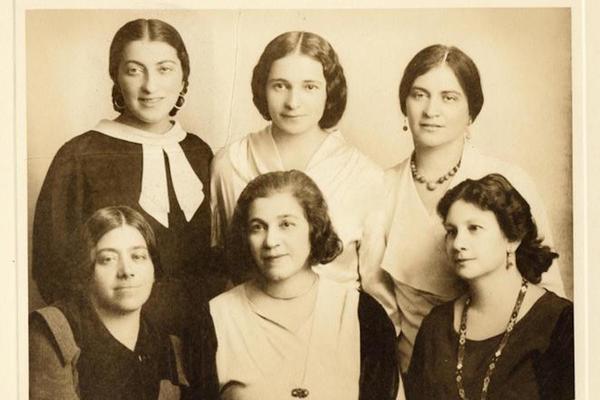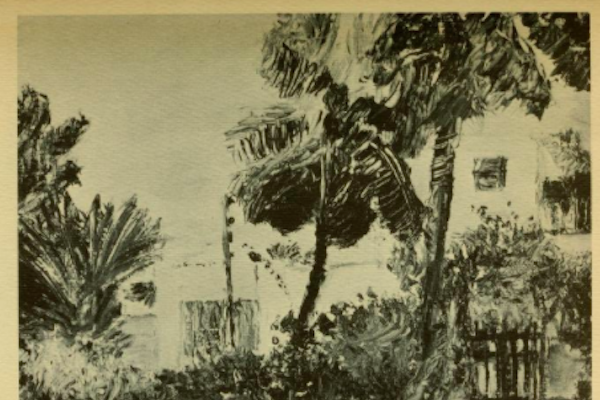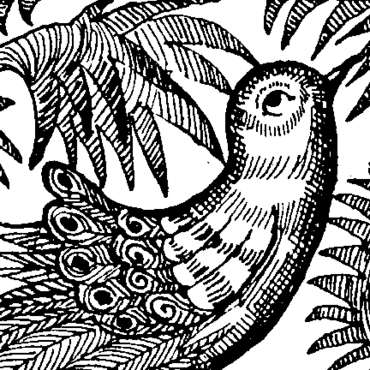
Acacias Bloom
- Written by:
- Dvoyre Fogel
- Translated by:
- Anastasiya Lyubas
- Published:
- Summer 2017/ 5777
- Part of issue number:
- Translation 2017
Dvoyre Fogel (Dvora Vogel) (1900–42) was a Yiddish modernist writer, philosopher, art critic, and translator. She was a “wandering star” who inhabited interstitial spaces not only between Polish modernism and the Yiddish modernist renaissance movement in Eastern Europe and North America but also between genres of artistic expression. Her illuminating writing style has qualities akin to painting and the plastic arts. Fogel’s collection of prose montage, Acacias Bloom, was published first in Yiddish (1935) and then in Polish (1936). The collection transplants experiments in the genres of photography, film, and painting into the literary medium. The translated excerpts are from “Flower Shops with Azaleas,” one of three parts in the Acacias Bloom collection. The montage pieces create an interplay of colors, geometric shapes, and other visual sensations. They are based on the logic of simultaneity in juxtaposed impressions: the round shape of blooming azaleas in a flower shop, for example, or the rectangle as the shape of a soldier’s march.
1. Streets and Sky
That day, streets reflected the sky. And the sky was gray and warm. And when the sky is gray, the streets are matte and sweet, like a warm gray sea.
The people who found themselves on the street that day were dying for some kind of encounter. And finally, an awkward and inexplicable longing emerged to immerse themselves in an elaborate novel, even an old-fashioned one.
Surely, the novel had to open with the following sentences: “That day . . .” and “In the gray clarity of a day with streets like gray seas, [the calendar date comes here], a man in a gray coat and a black bowler hat strolled along L. Street, reflecting on his life up to that point . . .”
The novel had to start in that style and everything in the novel had to begin with a similar effect, since there is demand for that now. And the novel would recount the course that life could take and how fates are made out of nothing: out of blue air, tacky boredom, and a single banal encounter.
And like a matter still not settled—though it has been experienced for many years—a long-forgotten sentence began to gnaw: “How does one live?” The question was just as banal as it was before, as ignorant of its own banality as it was the first time.
Meanwhile, on the streets as gray as the sea, the new romance of ordinary life had begun, as yet unnoticed by the many passersby.
The streets in that novel smelled of elasticity, of glass, and of walking. They smelled, also, of something unusual: the hardness and roundness of objects.
In those streets of that novel, the sticky space hardened into things of unusual kinds: spheres and flat planes, mostly gray and white.
The appearance of dense canvases of white space is treated like an event. Walls occur in this novel, thick like longing and the sweltering heat. Walls: whiter than in reality, melancholy white or hard white.
And there are surfaces—spherical, square, and rectangular (in everyday nomen- clature: furniture, dresses, pavement, and figures).
And so the first chapter of the novel begins more or less in this way: “In gray skies, walls rise, smooth like satin. Walls rise, similar to lacquer or paper. Figures walk the streets, figures taken from the novel called Life”.
4. Spring and Hat Boxes
Meanwhile, spring surged with canvases of lush greenery, which later, upon closer observation, split into fingerlike lilac leaves, unassuming and similar to human hearts.
A sea of greenery surged in front of the windows of houses and streetcars. Approaching noon, it swelled like a sea of gray water only to calm with noon’s arrival, and it froze into a clump of greenness in the evening.
And in this way the second month of sticky buds and blue air passed.
At that moment—although also now, as usual, for essentially no clear purpose— people decided to “live.” And everyone understood that word “life.”
And one started to prepare for the days when the heat blooms like a round, stiff glass flower just as one prepares for a long-awaited encounter.
So people treated the event of greenery as an encounter with life itself, which was—how typical of that time—represented by lacquered and helpless heat and unheard-of possibilities, as was typical.
But just as usual, this event took on an unexpected, if banal, course, namely: suddenly all the sidewalks and squares were covered with the flaxen cardboard and paper of hat boxes from women’s millinery shops, just like the pink petals of chestnut trees cover the gray streets of June.
On the sidewalks and squares spun female torsos: ancient torsos without eyes for the waves of lush greenery and for the multitudes of miscellaneous delicate things, which were happening all around and which were to change shortly.
That which was within people’s power was being done: they made arrangements to receive what had been prepared for life. And it turned out that porcelain torsos with breasts are capable of receiving life properly only if they are wearing new, as-yet-unworn clothes. But the fashion that year, 1933, was to use thick, direct materials in which one could still sense the lust-aesthetic of raw materials. But for colors: warm chrome and matte; contemplative sienna.
On this occasion, perhaps for the first time, people discovered the incomprehensible but indubitable effect of as-yet-unused elastic materials. It was noted that they helped to forget decaying things, which nothing could help anymore.
So, for that reason, they could help one live.
6. Rainy Days
Then came a series of rainy days. According to the calendar, the days were supposed to be as though composed of yellow lacquer, which sticks to the fingers and to the soul, and of incomprehensible vastness, when everything takes on an unexpected meaning.
But this year a shabby and dense grayness enveloped the days. And once again one needed to lean against the dazzling wall of posters as if pretending to wait for someone with whom one had arranged a meeting, although there was no one to wait for.
And certain afternoons and evenings were just like in an old-fashioned hit song where one “waits forever, waits again, without knowing what one is waiting for.”
These were unmistakable words, which recalled the sticky and resigned odor of dresses worn until threadbare. And which recalled the withered and helpless situations that one bears in the soul: one cannot live.
But on those rainy days in 1933, people rehabilitated the thing and the fatalism, which was occurring to people at that moment. And as usual, when things were already so banal, an event happened so far removed from life it was as if it were altogether fictional.
It was also noted then that even the figure of heroic life, which had been associated for some time with the figure and melody of a rectangle, now bore a drop of melancholy in the gray elongation of its lines. Perhaps life requires a drop of melancholy?
And so unexpected possibilities became stories of “broken hearts,” of “streets that want nothing more” and “waiting for life.” It was as if all of that belonged to life now.
During those days, gray from the rain, a tango with the following lyrics played every evening for the whole month in the Femina bar: “It is all, or nothing at all . . .”
7. Flower Shops with Azaleas
In the city of blue grayness and five million legs, there are also shops with huge, flat, spherical flowers.
Azaleas in the flower shop on the Boulevard Montparnasse in Paris are perfect. Their color is like that of salmon or oranges; in fact, they reflect a hundred shades of lox or round oranges.
Azaleas from the Boulevard Montparnasse in Paris no longer need the drawn-out and contemplative fragrances of ordinary flowers. They could be made of satin, odorless brass: they have poured their whole soul into the color, which is full of sad experiences, like brass itself.
This event takes place in the summer of 1933, at the same time as the other events described here.
A great sadness suddenly passes through the bustling Boulevard Montparnasse, a brass sea of melancholy. It seeps—no one knows how—from the shop filled with azaleas.
The day is gray, one in a series of gray days. People search for hard objects to hold in their hands; they search for distinct and unambiguous events. And this thing, which is taking place here at the azalea shop, in fact, completely resembles something known for a long time, a usual thing, but for a long time one could not remember where this dull and colorless burden had come from. Until suddenly one knows that what is happening now on the Boulevard Montparnasse always happens when a thing is settled and when nothing can be done about it anymore.
In front of the shop with the brass azaleas that have no fragrance, as if they had tried on all possible fragrances, life suddenly becomes like a long, gray stretch where everything is already settled and everything that was supposed to happen has already passed.
And suddenly, perfect things and sweet encounters and elegant azaleas the color of lox become unbearable. And suddenly houses, formless and too large, fill with things and people. One desires “missed opportunities” and “failed romances” and “unhappy loves.”
The weeds of longing grow and spread, longing for things full of coarse solitude and for the bleary burdock leaves of unrest.
And like a grotesque tagline of a pulp novel, the following sentences form: “Among perfect things there is no longer a place for life. . . This is where abandonment and sadness come from, which goes hand in hand with every nice thing. That’s why people need a bit of raw disorder and abandonment in life in general . . .”
And who would have thought that these far-reaching conclusions would have stemmed from unimportant azaleas, as if made of sad brass?
Yet that’s how life works: the most meaningless things remind us of the most important things in life.
8. Soldiers March On
That summer, which came at last, was unusual and inconsistent with the calendar.
It started and went by without yellow heat, without butterflies and the birds of summer. And yet it happened. It could be recognized from the green of the trees, which grew darker. Later, from the spotty yellowing of the chestnut trees.
Such a summer was hard to reckon with: people allowed the leaves to darken and yellow again, and the “hearts” (what an old-fashioned word) got over missed opportunities.
And yet a few weeks ago, as happens every year at this time, people had decided to “live.” And now it was as if this decision were absolutely obliterated from memory. And people wished for nothing and did everything without conviction, not engaging fully, as if unsure of what had to be done at this moment and how to proceed.
Later, on a particular day, an odd urgency: to accomplish everything that belonged to life.
And it was formulated in exactly that way: “to figure out life.”
And into this atmosphere of catastrophic excitement an event entered. It unambiguously expressed that the world stood, nevertheless, on its ancient, predetermined, and well-ground place, and that it was always possible to “come back to life.”
* * *
Soldiers march in the streets. They march in big rectangles of blue grayness, the gray of a warm November day without sun. They have soldiers’ uniforms. On their coats: precisely four polished buttons.
Attention: now the left leg goes up. Next: the right one. Each leg returns to the pavement forming a rigid, right angle with the street. And it transpired as if the soldiers were contemplating something very important with their feet, perhaps the flat, angular event of this march of large, blue rectangles composed from the soldiers’ uniforms.
On a particular predetermined day, otherwise the same as all other days, in the same place, the blue rectangle gushed with a coarse fountain of voices: for the most part, they sang a tango adapted to the rhythm of a march.
That syllogism of marching was no more or less significant than any other event. And it comes as no surprise that it can be treated with the full, sweet resignation that life deserves: as a self-explanatory thing.
And so one does not know what can become important in life. Each matter can differ from what it is supposed to be; it can become important: that rectangle of soldiers helped with “coming back to life.” To some extent, the whole process resembled everyday life.
Jasmine, acacias, and finally linden bloomed in turn.
And once again there was too little of life, just as before, when happiness determines its measure. This is what the blue rectangle of soldiers accomplished. It played the role of joy that summer, devoid of heats and flies.
9. Ships Carry Gold
Everything that has taken place so far happened in the summer of 1933 in the following way.
Everything was authentic. And as important to people as life, although the world was then full of events belonging to a quite different series and order.
These events contained the fate of matter. In fact—and it could not be defined otherwise—it was about regulating the helpless matter that had been bearing on people’s fate. From time to time the weeds of disorder overgrew the world, and then strange and blind need descends on people: the needs to rearrange and rework, to regulate life. Such a time had come.
At first the event took such shape.
Under the shabby door of a house in the Biedermeier style, 28 Skarbkovska Street, the unemployed wait. On every first and fifteenth day of the month, they come one by one, in alphabetical order. They go up the wooden, winding, worn-out stairs. They wait awhile. They wait through an uncountable period of time, the time until life can be seized.
Meanwhile, kings of oil, coal, and matches do not know what to do with these sticky materials. There are too many things in the world for them, and also nothing to be done with the surplus stock.
Then something happens that illustrates to what extent something can become more important than what it usually is and how it pertains to life—as in the case of Parisian azaleas and marching soldiers.
At that time it turned out that somehow, for some period, dirty stacks of commodities had drowned out the world’s supply of gold. At that time, the country of America, a landscape of concentration and balance, started to take away its gold from the unbridled and wanton, soft and pathetic Europe.
Berengaria, Georgic, and three other ships sailed from the ports. One insane ship was even called Manhattan. Nobody pays attention to nameless transportation. In that whole incident, what may turn out to be of most importance was the landscape of red gold over the cobalt of the sea, full of incomprehensible yet definitive contents.
The sticky residue of days spent processing the shabby and fat, expressionless and filthy matter of life still permeates the unemployed near the Biedermeier door. The pearls on foreign women sprayed with Paris Twilight perfume, yet full of the tacky and flat odor of boredom and bitterness, rigid like a burdock leaf.
It is, apparently, still not important to the planned epic of life and waits, and it waits until everything excessive is resolved. However, the thing that will happen shortly is angular.
It comes shortly. It takes on a shape of nagging longing for gray noise, for the helpless sweetness of flat things, for the full roundness and mild melancholy of rectangular objects.
Then there will be no more time for the questions “Why?” and “For whom?”
21. Second Commentary
This is not yet a novel we feel passionate about, in a sudden and sweet way. It is precisely the beginning of the year, a day of gray skies and streets like seas and skies.
Yet in this way life has to be dealt with in every future novel: as a chronicle where everything belongs and where there is no plot development.
The chronicle knows no events that would be more important than others. Here everything is important and necessary in the same measure.
The chronicle does not single out the sharp contours of tragic experiences or blocks of resignation. Hence the monotony, hence that sometimes unbearable repetition.
Life is like a chronicle: a block, anonymous and unpretentious. Only upon closer examination can the sticky and wanton mass of life be divided into singular fates and particular details. Just like in June or July, one divides the block of green into individual stems and leaves.
At any point, life can be put on hold and then picked up: like a chronicle of the year, interrupted in the month of November, made from copper brass, sad and fantastical, “like life itself.”
ANASTASIYA LYUBAS is a PhD candidate in comparative literature at Binghamton University, where she is at work on her dissertation, Language and Plasticity in Debora Vogel’s Poetics. Anastasiya is also currently a Yiddish Book Center translation fellow.




